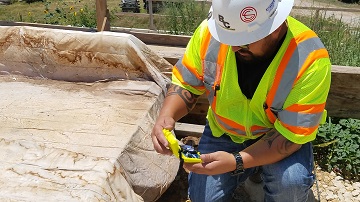 Thursday, April 25, 2024
Thursday, April 25, 2024  Thursday, April 25, 2024
Thursday, April 25, 2024 
Wireless Bluetooth maturity systems are typically available as one of two options: with a transmitter that is completely embedded within the concrete, or with a transmitter that sits outside of poured concrete. Both options have benefits and limitations to consider before choosing a maturity system for your project.
The maturity method, often simply referred to as maturity, is a way of evaluating new concrete’s in-place strength by relating time and temperature measurements to actual strength values. Typically, in-situ strength estimation is achieved through standard test methods which involve flexural or compressive tests of beam or cylinder specimens. However, concrete in the field does not always gain strength at the same rate as test specimens. Maturity testing addresses this guesswork and can prove if on-site concrete has achieved required strength and whether or not formwork removal and load application is feasible.
In the past, maturity testing has been performed by placing sensors into fresh concrete and then connecting a data logger or other maturity reader directly to each sensor to retrieve and analyze the data. In recent years, Bluetooth® technology has been incorporated into concrete maturity systems to ease data collection and allow for wireless sharing.
Bluetooth provides the ease of immediate connection between electronic devices such as mobile phones, computers, and wired sensors. However, Bluetooth does have some limitations. Bluetooth uses a 2.4GHz frequency to transmit data and frequently competes with other radio waves for transmitting information to its receiving device. Other devices that operate under a similar frequency include microwaves, wireless speakers, satellite dishes, monitors, cameras, cordless phones, power lines, and power stations. Water is an additional substance that can reduce the Bluetooth signal, so weather disturbances and even humans (with a significant volume of water in our bodies) standing between the transmitter and the receiver will slow down or inhibit the connection.
Wireless Bluetooth maturity systems are typically available as one of two options: with a transmitter that is completely embedded within the concrete, or with a transmitter that sits outside of poured concrete. Both options have benefits and limitations to consider before choosing a maturity system for your project.